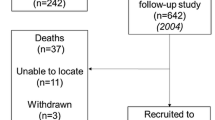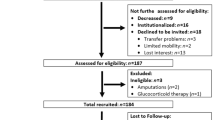Abstract
Telomere length (TL) attrition is associated with chronic diseases characterized by chronic inflammatory states. Inflammatory cytokines may play a role in sarcopenia. This study examines the association between TL and the diagnosis of sarcopenia based on appendicular skeletal mass index (ASMI), grip strength, walking speed, and chair stand in a prospective study over 5 years of 976 men and 1,030 women aged 65 years and over living in the community. TL in leukocytes was measured using the quantitative PCR method. TL was divided into quartiles, and analysis of covariance (ANCOVA) was adopted to examine its association with components of sarcopenia, adjusting for age, education, body mass index, smoking, physical activity, and probable dementia. In both men and women, the percentage decline in grip strength over the 5-year period of follow-up was slower in those in the highest quartile of TL than those in the lower quartiles (multivariate-adjusted p < 0.05). No association between TL and the diagnosis of sarcopenia, ASMI, walking speed, or chair stand was observed. In conclusion, longer TL was associated with slower decline in grip strength in Chinese older persons.
Similar content being viewed by others
References
Cawthon RM (2002) Telomere measurement by quantitative PCR. Nucleic Acids Res 30(10):e47
Cesari M, Kritchevsky SB, Nicklas B, Kanaya AM, Patrignani P, Tacconelli S, Tranah GJ, Tognoni G, Harris TB, Incalzi RA, Newman AB, Pahor M (2012) Oxidative damage, platelet activation, and inflammation to predict mobility disability and mortality in older persons: results from the health aging and body composition study. J Gerontol A: Biol Med Sci 67(6):671–676
Chan TS, Lam LC, Chiu HF, Prince M (2003) Validity and applicability of the Chinese version of community screening instrument for dementia. Dement Geriatr Cogn Disord 15(1):10–18
Chen LK, Liu LK, Woo J, Assantachai P, Auyeung TW, Bahyah KS, Chou MY, Chen LY, Hsu PS, Krairit O, Lee JS, Lee WJ, Lee Y, Liang CK, Limpawattana P, Lin CS, Peng LN, Satake S, Suzuki T, Won CW, Wu CH, Wu SN, Zhang T, Zeng P, Akishita M, Arai H (2014) Sarcopenia in Asia: consensus report of the Asian working group for sarcopenia. J Am Med Dir Assoc 15(2):95–101
Cruz Jentoft AJ for the International Sarcopenia Initiative (2014) Prevalence and interventions for sarcopenia in ageing adults—a systematic review report of the international sarcopenia initiative (EWGSOP and IWGS). Age and ageing
Du M, Prescott J, Kraft P, Han J, Giovannucci E, Hankinson SE, De Vivo I (2012) Physical activity, sedentary behavior, and leukocyte telomere length in women. Am J Epidemiol 175(5):414–422
Evans WJ, Morley JE, Argiles J, Bales C, Baracos V, Guttridge D, Jatoi A, Kalantar-Zadeh K, Lochs H, Mantovani G, Marks D, Mitch WE, Muscaritoli M, Najand A, Ponikowski P, Rossi Fanelli F, Schambelan M, Schols A, Schuster M, Thomas D, Wolfe R, Anker SD (2008) Cachexia: a new definition. Clin Nutr 27(6):793–799
Gil ME, Coetzer TL (2004) Real-time quantitative PCR of telomere length. Mol Biotechnol 27(2):169–172
Heymsfield SB, Smith R, Aulet M, Bensen B, Lichtman S, Wang J, Pierson RN Jr (1990) Appendicular skeletal muscle mass: measurement by dual-photon absorptiometry. Am J Clin Nutr 52(2):214–218
Higuchi R, Fockler C, Dollinger G, Watson R (1993) Kinetic PCR analysis: real-time monitoring of DNA amplification reactions. Biotechnology (N Y) 11(9):1026–1030
Hoffmann J, Spyridopoulos I (2011) Telomere length in cardiovascular disease: new challenges in measuring this marker of cardiovascular aging. Futur Cardiol 7(6):789–803
Kong CM, Lee XW, Wang X (2013) Telomere shortening in human diseases. FEBS J 280(14):3180–3193
Lorenzi M, Onder G, Vetrano DL, Landi F, Bernabei R, Marzetti E (2014) Shorter telomeres in peripheral blood lymphocytes from older community-dwellers with sarcopenia. J Frailty Aging 3(1):35
Ludlow AT, Zimmerman JB, Witkowski S, Hearn JW, Hatfield BD, Roth SM (2008) Relationship between physical activity level, telomere length, and telomerase activity. Med Sci Sports Exerc 40(10):1764–1771
Ludlow AT, Ludlow LW, Roth SM (2013) Do telomeres adapt to physiological stress? Exploring the effect of exercise on telomere length and telomere-related proteins. BioMed Res Int 2013:601368
Ma SL, Lau ES, Suen EW, Lam LC, Leung PC, Woo J, Tang NL (2013) Telomere length and cognitive function in southern Chinese community-dwelling male elders. Age Ageing 42(4):450–455
Mather KA, Jorm AF, Milburn PJ, Tan X, Easteal S, Christensen H (2010) No associations between telomere length and age-sensitive indicators of physical function in mid and later life. J Gerontol A: Biol Med Sci 65(8):792–799
Mathur S, Ardestani A, Parker B, Cappizzi J, Polk D, Thompson PD (2013) Telomere length and cardiorespiratory fitness in marathon runners. J Investig Med Off Publ Am Fed Clin Res 61(3):613–615
McGrath M, Wong JY, Michaud D, Hunter DJ, De Vivo I (2007) Telomere length, cigarette smoking, and bladder cancer risk in men and women. Cancer Epidemiol, Biomark Prev: Publ Am Assoc Cancer Res, CosponsoredAmerican Soc Prev Oncol 16(4):815–819
Prince M, Acosta D, Chiu H, Scazufca M, Varghese M (2003) Dementia diagnosis in developing countries: a cross-cultural validation study. Lancet 361(9361):909–917
Puterman E, Lin J, Blackburn E, O’Donovan A, Adler N, Epel E (2010) The power of exercise: buffering the effect of chronic stress on telomere length. PLoS One 5(5):e10837
Sanders JL, Newman AB (2013) Telomere length in epidemiology: a biomarker of aging, age-related disease, both, or neither? Epidemiol Rev 35:112–131
Starr JM, Shiels PG, Harris SE, Pattie A, Pearce MS, Relton CL, Deary IJ (2008) Oxidative stress, telomere length and biomarkers of physical aging in a cohort aged 79 years from the 1932 Scottish mental survey. Mech Ageing Dev 129(12):745–751
Wang H, Chen H, Gao X, McGrath M, Deer D, De Vivo I, Schwarzschild MA, Ascherio A (2008) Telomere length and risk of Parkinson’s disease. Mov Disord 23(2):302–305
Washburn RA, Smith KW, Jette AM, Janney CA (1993) The Physical Activity Scale for the Elderly (PASE): development and evaluation. J Clin Epidemiol 46(2):153–162
Woo J, Tang N, Leung J (2008a) No association between physical activity and telomere length in an elderly Chinese population 65 years and older. Arch Intern Med 168(19):2163–2164
Woo J, Tang NL, Suen E, Leung JC, Leung PC (2008b) Telomeres and frailty. Mech Ageing Dev 129(11):642–648
Woo J, Suen E, Tang NLS (2010) Telomeres and the ageing process. Rev Clin Gerontol 20:1–9
Zhang WG, Zhu SY, Bai XJ, Zhao DL, Jiang SM, Li J, Li ZX, Fu B, Cai GY, Sun XF, Chen XM (2014) Select aging biomarkers based on telomere length and chronological age to build a biological age equation. Age (Dordr) 36:1201–1211
Conflict of interest
The authors have no conflict of interest to declare.
Author information
Authors and Affiliations
Corresponding author
About this article
Cite this article
Woo, J., Yu, R., Tang, N. et al. Telomere length is associated with decline in grip strength in older persons aged 65 years and over. AGE 36, 9711 (2014). https://doi.org/10.1007/s11357-014-9711-7
Received:
Accepted:
Published:
DOI: https://doi.org/10.1007/s11357-014-9711-7




